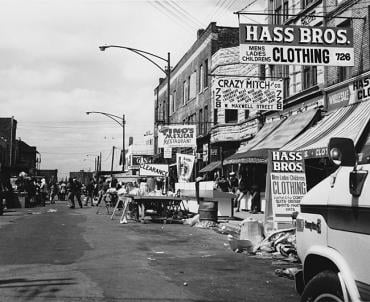Maxwell Street
Maxwell Street

Credit: Chicago History Museum
Maxwell Street was Chicago’s Sunday morning. Since you were skipping church to be there, you could catch a preacher with a megaphone or hear a gospel tune or the wake-up call of the blues. And while it had been years since Muddy Waters or Howlin’ Wolf played on the street with their amps plugged into storefronts, music blessed and beastly, good and lousy, was abundant. It was an ad hoc here-today-gone-tomorrow market. Vendors sold off tables, rolling racks, the backs of vans, the hoods of cars, the very street itself. You could buy new clothes that looked as though they had recently been liberated from a men’s shop, African-inspired clothing, used clothes, old clothes, music on LPs, music on cassettes. You could see the spot where everyone cut demo 45s in the 1940s and 1950s. You could buy books of which owners had tired, electronics that might work, dishwear that might match (or not), blenders, furniture, toys in packaging never seen anywhere else in the city, hubcaps, car parts, and bad paintings. When you tired of walking up and down the crowded street and making sure you didn’t trip on the cracked sidewalk concrete, you could eat a Polish sausage or a pork chop, bone-in, at Jim’s Original World Famous Stand on the corner of Halsted and Maxwell Street.
You could revel in the homemade signs, bars with politically incorrect names, and the amazement of a store called Cheat You Fair. Stretching along Halsted from Roosevelt Road to 16th Street, Maxwell Street had been known as a key cross street going back deep into the nineteenth century. It provided a sensory, social, and economic experience like no other. While predominantly African-American, everyone was there: white, black, Asian, Latino, Mexican, young, old, middle-class, hustling working class, the down-and-out, and everywhere you turned, cameras clicking.
Maxwell Street was already feeling crowded by the Dan Ryan and UIC, and the Sears Tower loomed ominously over a street that had once been a Jewish market and home to Italians, Greeks, East Europeans, Poles, Germans, Swedes, and Irish. Though many stores on the street were still owned by people from the neighborhood, they had long since moved their homes to other areas of the city, leaving the future of legendary street in question.







